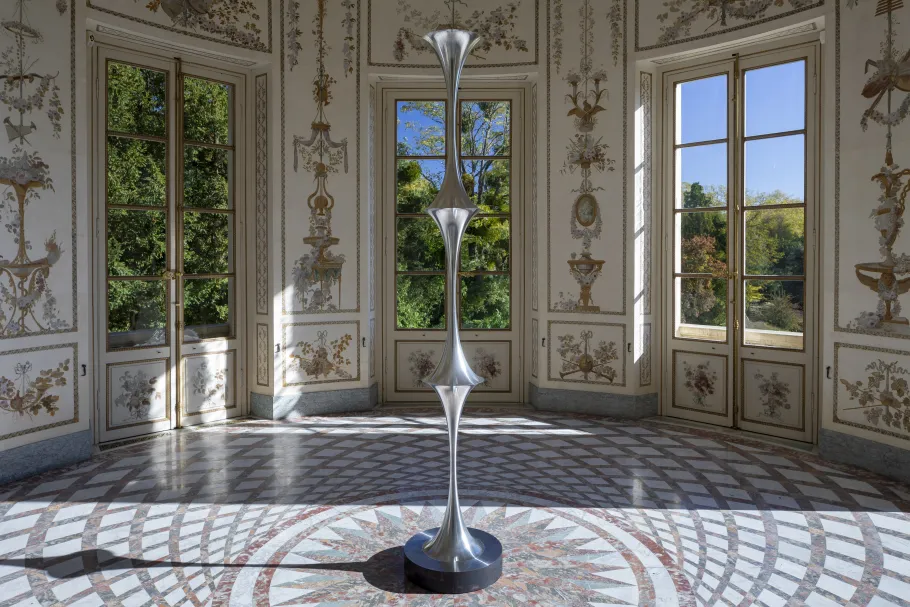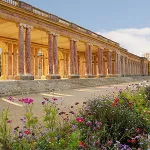For its eleventh exhibition of contemporary art, the Palace of Versailles invites the Japanese artist Hiroshi Sugimoto this autumn in a new emblematic place. The Japanese artist will invest the gardens of the estate of Trianon inviting art, architecture and performance.

From October 16 2018 to February 17 2019 Sugimoto Versailles
The exhibition
During the exhibition time, the Present breathes new life into the Past at Versailles. Hiroshi Sugimoto settles his installations in several spaces in the Estate of Trianon : Petit Trianon, Flat Pool, Belvedere, Queen's Theater, French Pavilion and the Garden Room. The artist presents the shadows of greats personnages who lived or marked the places : from Louis XIV who set up Montespan here to Marie-Antoinette who put the finishing touches to its aesthetic, it is a whole historic facet that Sugimoto reinvents through his installations. His art questions our relationship with photography and time : it is a practise that blends the modernist project with Japanese tradition and takes place in a unique and historical place : the Estate of Trianon.

Hiroshi Sugimoto
© Tadzio
The artist
Born in Tokyo in 1948, Hiroshi Sugimoto moved to the United States in 1970 to study photography. A multi-disciplinary artist, Sugimoto works in photography, sculpture, installation, and architecture. His art bridges Eastern and Western ideologies while examining the nature of time, perception, and the origins of consciousness. In 2009 he established the Odawara Art Foundation, a charitable nonprofit organization to promote traditional Japanese performing arts and culture.
Sugimoto’s art works have been exhibited around the world and are in numerous public collections including The Guggenheim, The Metropolitan Museum of Art, and the Museum of Modern Art in New York; the Smithsonian Institution in Washington, D.C.; the National Gallery and the Tate Gallery in London; and the National Museum of Modern Art and the Museum of Contemporary Art in Tokyo.
photographies of the exhibition
the booklet of the exhibition
Catalog of the exhibition

Sugimoto Versailles, Surface of Revolution. Catalog
Directed by Jean de Loisy, President of the Palais de Tokyo,
and Alfred Pacquement, curator of contemporary art at Versailles
Publisher: Flammarion, 96 pages, 23.5 x 31 cm
Date of publication: 28 November 2018
Contemporary art in Versailles
Since 2008 the Palace of Versailles has put on a number of exhibitions dedicated to French or foreign artists, each one lasting a few months. Jeff Koons in 2008, Xavier Veilhan in 2009, Takashi Murakami in 2010, Bernar Venet in 2011, Joana Vasconcelos in 2012, Giuseppe Penone in 2013, Lee Ufan in 2014, Anish Kapoor in 2015, Olafur Eliasson in 2016 and the group show “a winter journey” in 2017 : these artists have all created a special dialogue between their works and the Palace and Gardens of Versailles.
For the first time, the artist Hiroshi Sugimoto will install his creations within the domain of Trianon, a domain dedicated to the privacy of sovereigns. His exhibition, "Surface de Révolution", will settle in several places in the estate of Trianon.
The estate of Trianon
In an attempt to gain some brief respite from courtly etiquette, the kings of Versailles built themselves more intimate spaces close to the main palace. Adjoining the Petit Parc, the estate of Trianon is home to the Grand Trianon and Petit Trianon palaces, as well as the Queen’s Hamlet and a variety of ornamental gardens.
Construction on the estate began under Louis XIV, who had the Grand Trianon Palace built at the far end of the northern branch of the Grand Canal. The estate is perhaps most closely associated with Queen Marie- Antoinette. The wife of Louis XVI regularly sought refuge at the Petit Trianon, where she commissioned marvellous landscaped gardens centred around a hamlet of cottages built in the rustic style then in vogue.
The Petit Trianon, considered to be royal architect Ange-Jacques Gabriel’s masterpiece, is something of a manifesto for the neo-classical movement. Completed in 1768, it provided Louis XV and his new mistress the Comtesse Du Barry with the privacy which was so sorely lacking at the palace. This new royal residence was in fact an extension of the king’s passion for the botanical sciences: he was keen to have a home in the heart of the gardens to which he devoted so much of his time and which, by the time of his death, were among the most richly-stocked in Europe.
Curators
Jean de Loisy, President of the Palais de Tokyo
Alfred Pacquement, curator for contemporary art in Versailles

Exhibition
Jean Cotelle (1646-1708) Gardens and gods
From June to September 2018, an exhibition dedicated to Jean Cotelle the Younger will be on display at the Grand Trianon. The exhibition will feature some 120 works,paintings, drawings, engravings, miniatures and sculptures from public and private collections.

Virtual experience
A virtual visit of the Queen's hamlet
The Queen's hamlet in the Trianon Gardens is an idyllic place for a stroll. Upon restorating and refurnishing the key feature of the Hamlet, discover it in 3D wherever you are.













